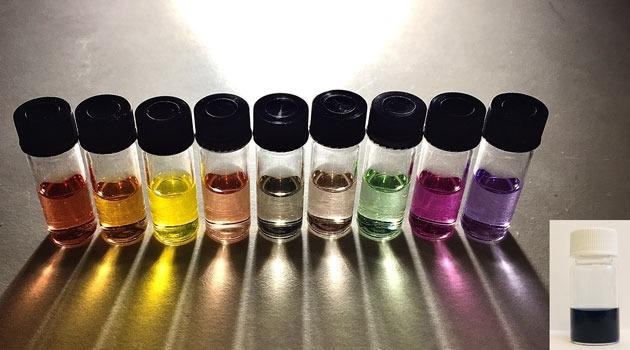Feb 15 2021
Photocatalytic composite polymer nanoparticles have been used by researchers from Uppsala University to develop an eco-friendly method for extracting hydrogen for energy use from sunlight and water.
 The polymer dots in the black solution (inset image) can absorb more light, and show better photocatalytic properties, than the single-component polymer dots in the colored solutions. Image Credit: P-Cat.
The polymer dots in the black solution (inset image) can absorb more light, and show better photocatalytic properties, than the single-component polymer dots in the colored solutions. Image Credit: P-Cat.
During laboratory tests, such 'polymer dots' exhibited promising stability and performance. The research has been reported in the Journal of the American Chemical Society.
Until now, meeting the future demand for sustainable energy has been a controversial question. One possible method is to use hydrogen, which can be synthesized from renewable resources: solar energy and water.
However, the process needs so-called photocatalysts. Conventionally, these have been made of metal-based materials that are usually toxic.
By contrast, a research group led by Haining Tian, Associate Professor (Docent) of Physical Chemistry at Uppsala University, has been making efforts to develop nano-sized organic photocatalysts. These 'polymer dots' are developed to be both economical and eco-friendly.
As polymer dots (Pdots) are very small, they are distributed uniformly in water. In contrast to conventional photocatalysts, this offers a huge reaction surface, which implies that more light can be stored in the form of hydrogen gas.
Currently, the research group has developed a Pdot which contains three components. The particle has exhibited excellent stability and catalytic performance in the tests conducted.
Combining several components that absorb light at different wavelengths is the easiest way to create a system in which all the visible surfaces capture light. But getting these components to work well together in a photocatalytic system is challenging.
Haining Tian, Associate Professor (Docent) of Physical Chemistry, Uppsala University
The Pdot was Exposed to Light
To examine how well the different components perform jointly, Tian and his collaborators employed spectroscopic methods where the Pdot was exposed to light for a specific length of time. Thus, they could track how photochemical intermediates form and, under illumination, vanish.
It’s exciting to see that both ultrafast energy transfer and electron transfer take place in one particle, and that this helps the system to make use of the light and separate the charge for the catalytic process.
Aijie Liu, Study Lead Author and Postdoctoral Researcher, Department of Chemistry–Ångström Laboratory, Uppsala University
The team has successfully improved the system of triple-component polymer dots to catalyze the transformation of solar energy into hydrogen with an efficiency rate of 7% at 600 nm.
This is considerably better when compared to the 0.3% at 600 nm achieved by the researchers when they used Pdots that include only one component. One existing issue is that the photocatalysts tend to degrade prematurely, but currently the team could not find any evident degradation even after 120 hours of testing.
Journal Reference:
Liu, A., et al. (2021) Panchromatic Ternary Polymer Dots Involving Sub-Picosecond Energy and Charge Transfer for Efficient and Stable Photocatalytic Hydrogen Evolution. Journal of the American Chemical Society. doi.org/10.1021/jacs.0c12654.